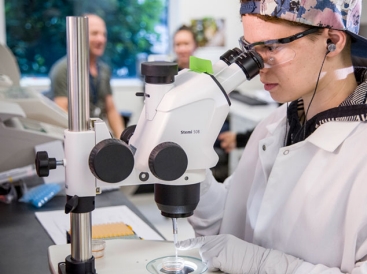Monitoring Safety of Engineered Cells
Tracking of Genetically Engineered Cells
Despite the invaluable therapeutic benefits that cell engineering can offer, virus-mediated gene transfer can present significant risks including dysregulation of nearby genes and dangerous clonal outgrowths. This warrants additional measures to research and improve upon the safety of this treatment. In order to better understand the safety profile of various engineered virus vectors, the Adair lab has co-developed novel methods to carefully track genetically engineered blood cell clones after they have been returned to the patient. This involves the fields of genetics, cellular and molecular biology, computer programming and bioinformatics.

Analysis of Engineered Viruses in the Adair Lab
Each engineered virus particle that enters a blood cell will deposit its therapeutic payload into a different spot in the DNA of the cell. This spot is called the “site of integration”. Thus, finding these sites in the DNA is called Integration Site Analysis (ISA). Our method of ISA allows us to analyze the effect of integration on nearby genes and permits continuous monitoring of specific engineered cells to make sure they don’t start to misbehave. This reveals a wealth of information about the engineered blood cells including but not limited to their longevity, level of contribution, and selectivity under a variety of conditions inside the body. Thus, we get to learn how our blood functions in addition to whether the cell engineering is safe.

DNA Barcoding in the Adair Lab
While ISA is necessary for establishing the safety of engineered virus-mediated therapy, it is fraught with bias and as such, is not a robust method for quantitating hematopoiesis, or the natural biology of blood cell development and function. It also cannot be used to glean information on the safety and performance of CRISPR gene editing, since this technique always makes changes to DNA in the exact same place. Another method is DNA barcoding. In this technique, the DNA is engineered to contain a small (20-30bp) fragment of random nucleotides. Because each of the 20-30 spots in this fragment can be any one of four bases in the DNA code, each DNA fragment has a unique sequence.
In collaboration with the laboratory of Dr. Matthew Porteus, we demonstrated that we could apply DNA barcoding to track engineered blood cells in nonhuman primates. By administering the DNA barcodes in an engineered virus particle, we were able to directly compare ISA and DNA barcoding methods in the same subjects, side-by-side. We learned that DNA barcoding is superior to ISA for studying blood cell biology after engineering. Current research includes development of additional DNA barcode libraries to better quantitate differences in engineered cell performance and safety.

© 2025 Fred Hutchinson Cancer Center, a 501(c)(3) nonprofit organization.